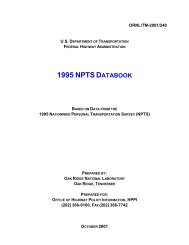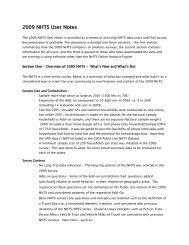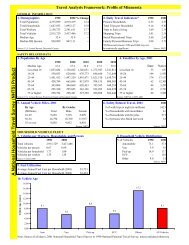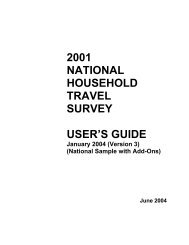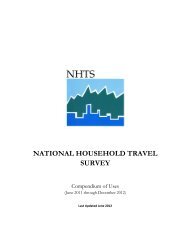Uses of National Household Travel Survey Data in - NHTS Home ...
Uses of National Household Travel Survey Data in - NHTS Home ...
Uses of National Household Travel Survey Data in - NHTS Home ...
You also want an ePaper? Increase the reach of your titles
YUMPU automatically turns print PDFs into web optimized ePapers that Google loves.
Special Population Groups<br />
Critical Factors for Active Transportation to School among Low-Income and M<strong>in</strong>ority Students:<br />
Evidence from the 2001 <strong>National</strong> <strong>Household</strong> <strong>Travel</strong> <strong>Survey</strong><br />
Authors:<br />
McDonald, Noreen C<br />
American Journal <strong>of</strong> Preventive Medic<strong>in</strong>e Issue: 4<br />
4/1/2008<br />
Abstract:<br />
This article reports on a cross-sectional study that used data from the 2001 <strong>National</strong> <strong>Household</strong> <strong>Travel</strong><br />
<strong>Survey</strong> to document rates <strong>of</strong> walk<strong>in</strong>g and bik<strong>in</strong>g to school among low-<strong>in</strong>come and m<strong>in</strong>ority youth <strong>in</strong> the<br />
U.S. (n = 14,553). The authors developed b<strong>in</strong>ary models <strong>of</strong> the decision to use active transport to school<br />
that can simultaneously adjust for trip, <strong>in</strong>dividual, household, and neighborhood correlates. All analyses<br />
were conducted <strong>in</strong> 2007. The results showed that low-<strong>in</strong>come and m<strong>in</strong>ority groups, particularly blacks and<br />
Hispanics, use active travel modes to get to school at much higher rates than whites or higher-<strong>in</strong>come<br />
students. However, racial variation <strong>in</strong> travel patterns is removed by controll<strong>in</strong>g for household <strong>in</strong>come,<br />
vehicle access, distance between home and school, and residential density. The authors conclude that<br />
active transportation to school may be an important strategy to <strong>in</strong>crease and ma<strong>in</strong>ta<strong>in</strong> physical activity<br />
levels for low-<strong>in</strong>come and m<strong>in</strong>ority youth. Current policy <strong>in</strong>terventions such as Safe Routes to School<br />
have the opportunity to provide benefits for low-<strong>in</strong>come and m<strong>in</strong>ority students who are the most likely to<br />
walk to school.<br />
Subject areas and Index Terms<br />
Highways; Safety and Human Factors; I10: Economics and Adm<strong>in</strong>istration<br />
Blacks; Commut<strong>in</strong>g; Hispanics; <strong>Household</strong>s; Income; Low <strong>in</strong>come groups; M<strong>in</strong>orities; Private passenger<br />
vehicles; Race; Residential areas; School trips; Schools; Socioeconomic factors; Transportation modes;<br />
Walk<strong>in</strong>g distance; <strong>National</strong> <strong>Household</strong> <strong>Travel</strong> <strong>Survey</strong>; Safe Routes to School (Program)<br />
Availability: F<strong>in</strong>d a library where document is available Order URL: http://worldcat.org/issn/07493797<br />
36



